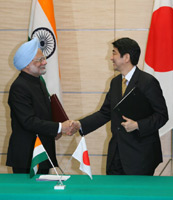This past summer, prior to his sudden departure from office, Japanese Prime Minister Shinzo Abe and his Indian counterpart Manmohan Singh announced a partnership agreement that surpassed the previously established levels of economic and security cooperation between the two countries. The timing of this August roadmap could not have been more perfect, given that 2007 is Japan-India Friendship Year. The new momentum in relations between the world's largest democracy and its second-largest economy deserves attention, in part because these relations have historically lacked both depth and breadth. Nevertheless, while recent efforts reflect a positive trend toward deeper engagement between Japan and India, several political and economic stumbling blocks remain in the path toward a more developed relationship. A Growing Relationship Since 2000, there has been a flurry of high-level diplomatic activity between Japan and India. Three Japanese prime ministers paid visits to New Delhi since 2000, culminating with the visit of Prime Minister Abe in August 2007. Abe was widely seen as a driving force in pushing strong relations between the two countries. He and Foreign Minister Taro Aso brought a bold strategic perspective on Japan-India relations, with talk of shared values, strategic interests, and an "arc of freedom and prosperity" stretching from East Asia to South Asia. The so-called quadrilateral partnership between Japan, India, Australia, and the United States -- which was born through practical cooperation as part of a regional core group after the 2004 Indian Ocean tsunami -- was nurtured and expanded under Abe's leadership.
Beyond Shared Values: the Outlook for Japan-India Relations

